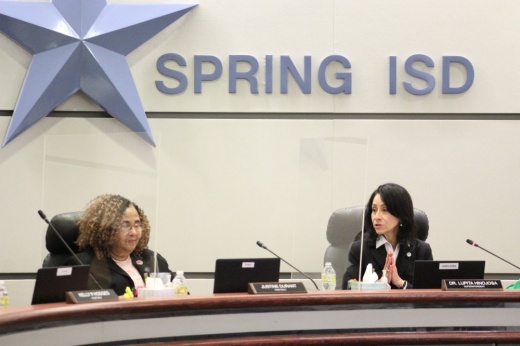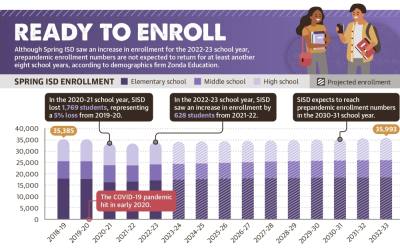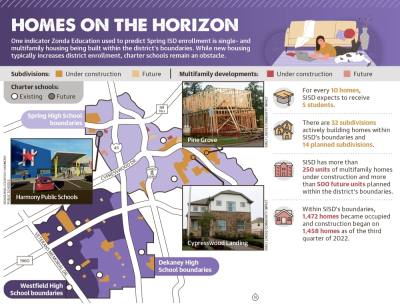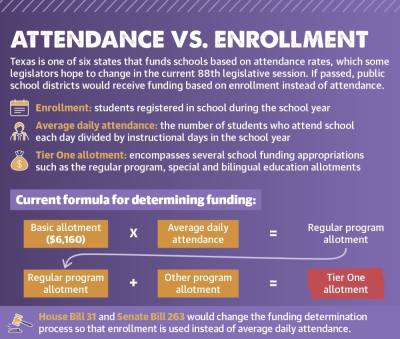SISD’s enrollment increased by 628 students for the 2022-23 school year, representing a 1.9% jump from the previous school year—the largest enrollment growth the district has had in more than a decade.
“We’re not seeing a lot of districts make a turn like this, I can tell you that. Districts at [Spring ISD’s] size ... and being impacted the way they were with charter [schools], and now they’re turning and seeing a positive turn,” said Rocky Gardiner, the director of school district consulting for Zonda Education.
At the same time, however, SISD has still not matched its prepandemic enrollment. During the 2018-19 school year, SISD had 35,385 students, over 1,300 more than the current school year.
Zonda projects SISD will not reach prepandemic figures until the 2030-31 school year.
“We are excited to see our enrollment begin to increase,” SISD Chief Financial Officer Ann Westbrooks said in a Feb. 7 email.
Along with enrollment, the coronavirus pandemic affected daily student attendance in school districts statewide, which, in turn, impacted funding. According to the Texas Education Agency, state funding for schools is determined based on a basic allotment per student who meets an attendance threshold.
In hopes of remedying these funding woes, Texas legislators filed bills in the 88th legislative session that would change the state funding mechanism so it is determined by enrollment.
Pandemic problems
After the pandemic hit in early 2020, SISD experienced enrollment decline, losing about 2,000 students.
However, Gardiner noted pandemic-caused enrollment losses were experienced statewide.
“Following COVID[-19] ... a lot of parents are making decisions with students. ... We’re assuming homeschooling,” Gardiner said.
Even prior to the pandemic, however, SISD was experiencing enrollment decline. In 2019, Zonda—then called Templeton Demographics—projected the district would lose more than 1,600 students by the 2028-29 school year. The main reason for this prediction was a growing presence of charter schools, Gardiner said in April 2019.
Charter schools continue to be an ongoing challenge for public school districts statewide, Gardiner said as they receive government funding, but do not have geographic zoning restrictions for enrollment.
Within SISD’s boundaries—which encompass parts of ZIP codes 77373, 77090, 77068, 77067, 77073 and 77014—there are 11 charter schools, according to the Texas Public Charter Schools Association. SISD has lost enrollment due to charter schools, Westbrooks said.
School of Science and Technology-Champions is one of several free public charter schools within SISD’s boundaries. According to Communications Specialist Natasha Turner, the campus has about 700 students enrolled in grades pre-K-8.
School of Science and Technology’s enrollment is a mix of students who grew up attending and who transferred in from public school systems, Turner said.
Over the next decade, SISD is expecting to face additional enrollment obstacles with the construction of multiple Harmony Public Schools campuses in master-planned community City Place, which is zoned to SISD. The charter school system will open its first campus before the 2024-25 school year.
Future of enrollment
One major factor that determines enrollment growth is the housing market, Gardiner said, noting the boost in enrollment SISD saw this year is due to new housing added within the district’s boundaries. During a Jan. 5 presentation to SISD’s board of trustees, Gardiner said he expects to see strong housing development this year.
“The housing growth that [SISD is] seeing right now is really strong, and I think it’s going to be beneficial to that community,” Gardiner said.
According to Zonda, every 10 homes occupied within the district adds an average of five students to SISD’s population.
Within SISD’s boundaries, 32 subdivisions are actively building houses and 14 additional subdivisions are expected to be added, according to Zonda’s report. In terms of multifamily housing, 250 units are currently under construction, and 500 more are expected in the future.
Neighborhoods with the most single-family homes to be added include Breckenridge Forest, Cypresswood Landing and Pine Grove with 135, 134 and 121 homes currently under construction, respectively, according to Zonda. All three of these communities are located off Cypresswood Drive and are zoned to Spring High School.
For multifamily homes, move-in is slated for early this year for Holzwarth Road’s Botanic Apartments, which includes about 300 units, according to the complex’s website, and is also zoned to Spring High School.
Even though SISD does not anticipate large enrollment growth in the next decade, the district will begin renovating campuses this year to “ensure the best possible learning environment” for students, Westbrooks said. Following the passage of an $850 million bond by voters in November, remodels are planned for Spring and Westfield high schools, as well as Jenkins and Reynolds elementary schools.
“Our facilities are aging and are in need of repair or replacement,” Westbrooks said. “The 2022 bond does not include building additional schools, which is what you would see with enrollment growth.”
Proposed legislation
To combat lingering funding issues that have arisen during the pandemic, state legislators are hoping to pass a bill making state funding for public school systems based on enrollment instead of attendance. This bill would help SISD, Westbrooks said.
“[SISD] would benefit by having a reliable source of revenues that are based on our student enrollment as opposed to a fluctuating amount of revenue that is dependent upon average daily attendance.”
Currently, the state finances schools through the basic allotment, which is the amount of money schools receive per student. Funding is based on average daily attendance, which is the sum of students present throughout the school year divided by the number of days schools are required to be open, according to the TEA.
Schools then earn $6,160 per student who meets the average daily attendance threshold. But when students are frequently absent, their schools lose money, even if the school’s day-to-day operations do not change. For funding purposes, students who are frequently absent are not counted at all, according to the TEA.
If passed, House Bill 31, filed by Rep. Gina Hinojosa, D-Austin, would require schools to be funded based on enrollment. An identical bill, Senate Bill 263, was filed by Sen. Nathan Johnson, D-Dallas.
“Under our current system ... school funding falls while costs are fixed,” Johnson said via an emailed statement Feb. 6.
As of press time Feb. 8, the bills had not yet entered any stages in the legislative process beyond initial filing.
Hannah Brol, Carson Ganong and Hannah Norton contributed to this report.








